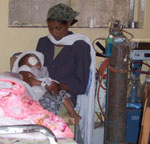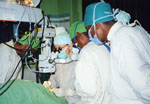
Return to Main Menu
|
Storm Eye helps countries through
twinning
The following article describes one of
many poster presentations set for this year’s faculty convocation Aug.
22. The Catalyst will highlight some of the presentations on MUSC’s
international clinical, educational and research opportunities and
outreach. Photos provided by Storm Eye Institute.
by
Heather Woolwine
Public
Relations
In basic science classes, students learn about the creation of a
long-standing and symbiotic relationship between two organisms. This
relationship, sometimes referred to as twinning, serves to benefit both
organisms and enrich their survival.
Such a relationship exists between the MUSC Storm Eye Institute (SEI)
and the Addis Ababa University (AAU) Department of Ophthalmology in
Ethiopia.
Formed more than five years ago, the memorandum of understanding
between the two universities seeks to accomplish several tasks. First
and foremost, the memo seeks to contribute a real and lasting effort to
“teach the teachers” in order to increase the training capacity of
international ophthalmology training programs.
According to the World Health Organization (WHO), 75 percent of world
blindness is unnecessary. Nearly 37 million people worldwide are blind,
28 million of whom may be candidates for potential life-altering
treatment.
 A mother holds her
sleeping child in the recovery area after eye surgery. A mother holds her
sleeping child in the recovery area after eye surgery.
“The program has been very successful,” said M. Edward Wilson,
M.D.,
SEI director and MUSC ophthalmology chairman. “The idea was to do this
for awhile, then move into a more mentor-like capacity, and then move
to the next university and establish a relationship there. However,
there is still such a great need in Ethiopia that we’re still there.”
When Wilson and SEI faculty began visiting Ethiopia to train AAU’s
ophthalmology faculty, only 45 Ethiopian ophthalmologists were
available to serve a population of more than 70 million people. Many of
their patients required surgery. While the number of local
ophthalmologists has doubled to 90 in the last five years, Wilson
emphasized that much work remains.
“Prior to this effort, our faculty conducted mission trips on their
own. We came to a consensus as an institute that our efforts would be
amplified by going in one direction at a time. I was already involved
with ORBIS (and had been approached to help with their strategic
planning so the fit became natural for them, AAU and us,” Wilson said.
ORBIS International’s initial outreach efforts began 25 years ago with
the acquisition of a DC-8 aircraft converted into a state-of-the-art
teaching facility, or “Flying Eye Hospital.” ORBIS later upgraded to
the DC-10 in circulation today. “I took many trips on the smaller
plane, and it was very cramped. The DC-10 is huge and very well suited
for surgery,” Wilson said.
(More information about the aircraft is included below.)
ORBIS describes itself as a non-aligned, non-profit global development
organization. “Our mission is to preserve and restore sight by
strengthening the capacity of local partners to prevent and treat
blindness,” according to the company’s Web site.
 Ethiopian natives
wait to be seen by ophthalmologists. Ethiopian natives
wait to be seen by ophthalmologists.
“Years ago, ORBIS decided that it needed to branch out more, and
we
were approached to pilot our twinning program with AAU with full
funding and sponsorship from ORBIS,” Wilson said. “Gene Howard (M.D.,
MUSC ophthalmology professor) and I visited Ethiopia and Vietnam, and
for various reasons decided that Ethiopia was the best fit. We agreed
to take on their (AAU’s) ophthalmology faculty as fellows here at MUSC
and in turn our faculty would also go over there as much as possible.
The dean of medicine for AAU also agreed to double the number of
ophthalmology faculty to accommodate the increasing need for
ophthalmologists. Sending our faculty is important because, without a
license in the U.S., the fellows cannot perform procedures at MUSC, so
that hands-on experience in their own environment really serves to
teach them how to perform the procedures.”
Since its inception, the program linking MUSC and AAU has graduated 12
fellows through a “sandwich” style curriculum. Wilson explained that
the fellows arrive from Ethiopia and stay for six months, after which
they head back home for the following three months to test their newly
acquired knowledge and skills.
“This is an excellent opportunity for them to figure out what they do
and don’t understand, what works in reality and what doesn’t in their
environment,” Wilson said. During the last three months of the
fellowship, AAU faculty returns to MUSC and for what Wilson deemed the
most productive portion of the fellowship.
“At that point, they have a very realistic view from trying out their
knowledge; they’ve gotten an instrument and equipment wish list
together; and they can discuss and work through problems they’ve
encountered once they returned home. And we’re not just teaching them
new skills, we’re also teaching them how to go back and teach their
colleagues. We help them set up the curriculum and show them what to
pass on.”
Wilson has been to Ethiopia four times since the program began and said
that the trips and fellowship training are just the beginning. Through
the use of Cyber-Sight, a unique telemedicine initiative led by ORBIS,
SEI faculty can provide educational support and advice on patient
evaluations to physicians at AAU. Fellows receive digital cameras and
are taught to take appropriate photos and upload them onto a gigantic
server.
 Dr. Ed Wilson, at
microscope, teaches physicians during an eye surgery in Ethiopia. The
physicians then traveled to MUSC as SEI fellows to complete their
training through the SEI/AAU twinning program. Dr. Ed Wilson, at
microscope, teaches physicians during an eye surgery in Ethiopia. The
physicians then traveled to MUSC as SEI fellows to complete their
training through the SEI/AAU twinning program.
From fellow to mentor and back again, case files, patient photos, text
and e-mails keep MUSC and AAU connected on a daily basis. “By agreeing
to serve as mentors, we have an obligation to stay in touch with our
fellows during the long term and provide them with as much help as we
can,” Wilson said.
The constant contact has provided fellows the ability to train their
countrymen. It has become key for recruiting and producing more
ophthalmologists in a country that desperately needs them.
Twinning
programs vs. mission trips
Humanitarian outreach efforts evoke images of groups or of a missionary
who visits countries bringing supplies, medicines, and providing life
saving or altering medical procedures. It's not that this tradition
mission is ineffective , since it is generous and provided with the
best of intentions. But Wilson explained the difference between
programs such as SEI’s and the typical week-long medical jaunt into a
developing country: “In terms of medicine, and specifically
ophthalmology, if a trip or relationship does nothing to increase a
country’s capacity-building abilities, then it’s really just a show.
When you work to build up a country’s capacity to treat its own people,
you are able to do more and more every time you go back, and that’s
what brings about real and far-reaching change. It’s never a good idea
to bring something or do something that can’t be done once you’re
gone,” he said.
It’s also important to consider the environment in which patients live
in order to provide them with the best treatment, Wilson said. Teaching
Ethiopian fellows how to do the latest and greatest procedure may sound
like a great idea, but if they don’t have the equipment, there is no
way to carry it out on a day-to-day basis once missionaries leave. For
instance, Ethiopian ophthalmologists currently use, and have perfected,
manual cataract surgery. While many American and European physicians
would consider this method archaic, it allows Ethiopian physicians to
perform cataract surgery at about $14 per surgery and to yield high
quality results.
“You can have all these wonderful new technologies but they have to be
appropriate,” Wilson said. “We take them as far as we can and then
sometimes they must go to another part of the developing world to learn
the best technique for those patients living in developing countries.”
Meanwhile, faculty from universities such as AAU can proceed to other
developing countries to teach medical residents what they’ve learned.
As the information gains speed and is passed from one developing
country to another, knowledge becomes the power to make a difference.
“It’s a small world, and we think university-to-university teaching
with a funding agency’s involvement is a much better, productive
alternative to the very nice, drop-in-a-bucket mission trips,” Wilson
said.
Similar to the AAU program, Wilson and his colleagues have begun
relationships with universities in Vietnam, Bangladesh and Nepal.
For additional information about ORBIS, go to http://www.orbis.org/bins/index.asp.
An in-depth look at
the Flying Eye Hospital
At the heart of ORBIS’s sight-saving work is the Flying Eye Hospital.
It carries a laser treatment facility and an operating room where
volunteer surgeons participate in procedures throughout the world. The
operations are broadcast both to the on-board classroom and to remote
conference rooms attended by local doctors eager to enhance their
skills. Volunteers pilot the unique aircraft flown to developing
countries, where the 25-member ORBIS medical team and visiting
volunteer doctors perform surgeries while training local
ophthalmologists. The international ORBIS team also conducts nursing,
biomedical engineering and system support training.
 The
Flying Eye Hospital visits a country by government invitation and,
in conjunction with the local medical community, tailors an ophthalmic
program to local needs. Many heads of state, ambassadors, ministers of
health and other government officials have expressed their admiration
and support for ORBIS’s programs and its active diplomatic role. The
Flying Eye Hospital visits a country by government invitation and,
in conjunction with the local medical community, tailors an ophthalmic
program to local needs. Many heads of state, ambassadors, ministers of
health and other government officials have expressed their admiration
and support for ORBIS’s programs and its active diplomatic role.
Since 1982, the international medical team has conducted treatment and
training programs in more than 70 countries. To date, more than a
million people have received direct medical treatment, and more than
93,000 health care professionals have enhanced their skills through
ORBIS programs in more than 80 countries. Most importantly, an
estimated 22.5 million children and adults have benefited from ORBIS
programs worldwide. The nonprofit ORBIS provides services that are free
of charge to both hosts and patients.
Friday, July 21, 2006
Catalyst Online is published weekly,
updated
as needed and improved from time to time by the MUSC Office of Public
Relations
for the faculty, employees and students of the Medical University of
South
Carolina. Catalyst Online editor, Kim Draughn, can be reached at
792-4107
or by email, catalyst@musc.edu. Editorial copy can be submitted to
Catalyst
Online and to The Catalyst in print by fax, 792-6723, or by email to
catalyst@musc.edu. To place an ad in The Catalyst hardcopy, call Island
Publications at 849-1778, ext. 201.
|


